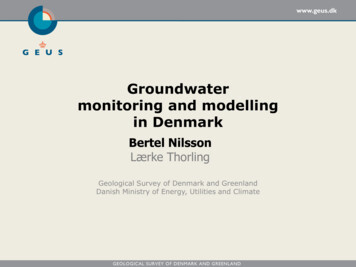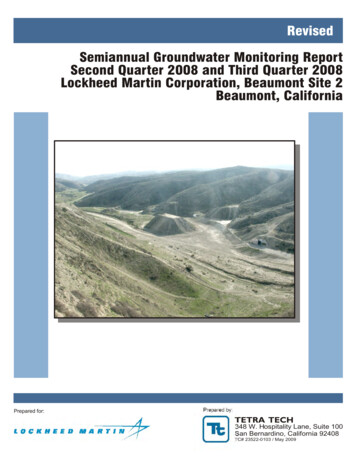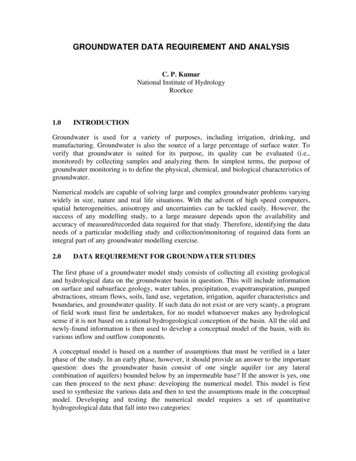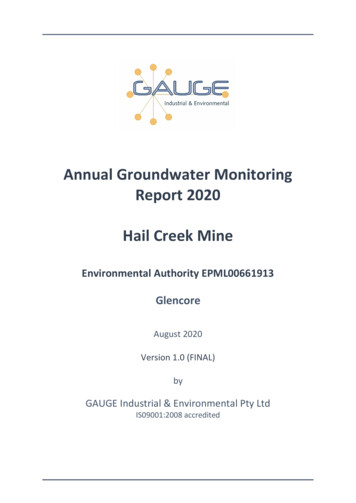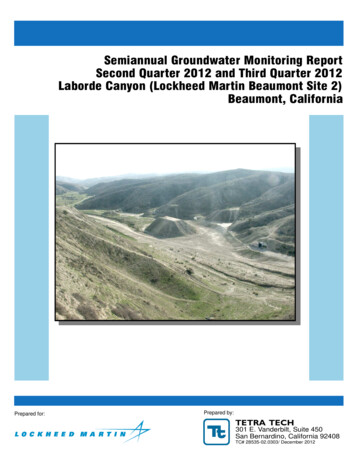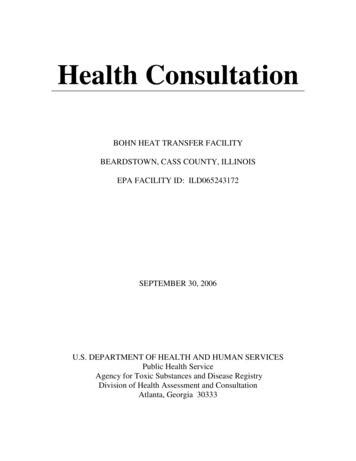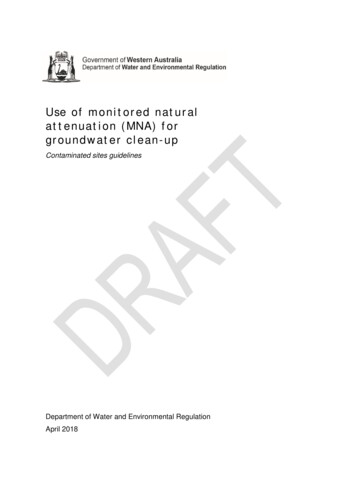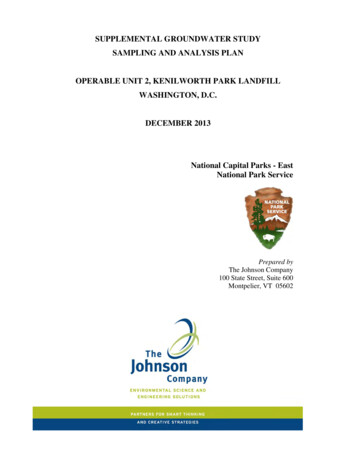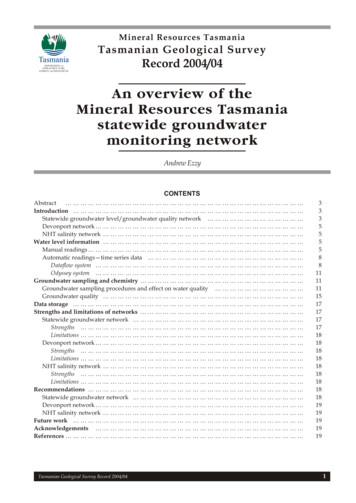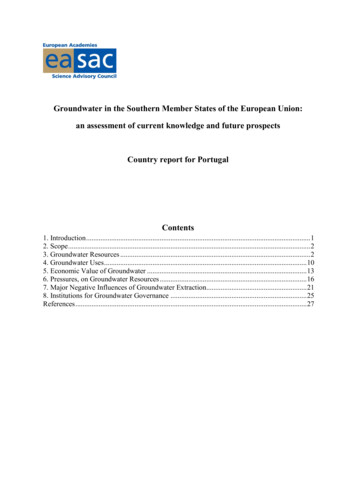
Transcription
Groundwater in the Southern Member States of the European Union:an assessment of current knowledge and future prospectsCountry report for PortugalContents1. Introduction . 12. Scope . 23. Groundwater Resources . 24. Groundwater Uses . 105. Economic Value of Groundwater . 136. Pressures, on Groundwater Resources . 167. Major Negative Influences of Groundwater Extraction. 218. Institutions for Groundwater Governance . 25References . 27
PORTUGUESE GROUNDWATER REPORT – EASAC WG ON THE ROLEOF GROUNDWATER IN THE WATER RESOURCES POLICY OFSOUTHERN EU MEMBER STATESLuís Ribeiro (Instituto Superior Técnico)Luís Veiga da Cunha (Universidade Nova de Lisboa)1. INTRODUCTIONFrom an hydrogeological point of view, Portugal is a favoured country. There is a largediversity of porous, karstic and fissured aquifers, where groundwater is stored in great quantities,interacting with surface water systems like rivers, estuaries and sea in a variety of climaticconditions, from the wet North to the dry South. There are also important hydro-mineral andthermal resources, with a relevant national economic value. About 20% of the geographicalextension of Portugal is occupied by 62 aquifer systems, of which 60 % are porous.Significant renewable groundwater resources are available in some aquifers of Portugal,mainly in the huge Tagus-Sado aquifer system, the major groundwater unit of the IberianPeninsula. In some aquifers under-exploitation may occurs, while in other areas, especially in theAlgarve region situations of groundwater over-pumping can occur, in some cases generating waterquality problems.Groundwater plays an important role in public, industrial and agricultural sectors, this lastone being the greatest consumer of groundwater.Groundwater resources are facing increasing pressures from those sectors. Climate changecontributes to an increase of water scarcity in Portugal specially in arid and semi-arid cases, as isthe case of some regions of south of Portugal, in Alentejo and Algarve (Cunha et al., 2006)Groundwater quality problems are due to the overload of aquifers with pollutants derivedfrom agriculture, from domestic and industrial landfills, or from the intrusion of saline water.1
These anthropogenic changes pose a significant, but largely unknown threat to the health ofgroundwater dependent ecosystems, which rely either totaly or partially on groundwater tomaintain their species, composition and natural ecological processes.The implementation of the European Water Framework Directive and its daughter Directiveon the Protection of Groundwater against Pollution, the so-called European Union GroundwaterDirective represents a tremendous challenge for the next years.The initial main criteria considered in the Directives were to define the groundwater statusfrom the point of view of quality (chemical) and quantity. Recently the ecological perspective wasintroduced recognizing the importance of the ecological functions of groundwater.2. SCOPEThe aim of this report is to give an overview of the current groundwater quality and quantityresources of Portugal. The information for preparing this overview comes only from the availableliterature. The following information and topics are included in this report: Groundwater resources Groundwater uses Economic value of groundwater Pressures on groundwater Major negative influences of groundwater extraction Institutions for groundwater governance3. GROUNDWATER RESOURCES3.1 Aquifer SystemsIn Portugal groundwater is unequally distributed in the territory due to differences inclimatic and geological conditions. From an hydrogeological point of view there are porous, karsticand fractured aquifers, which govern the conditions of storage and transmission of water.Groundwater is linked to surface water in many different forms. According to the geologicalcharacteristics Portugal is divided into four main hydrogeological unities: (Figure 3.1).2
Figure 3.1 - Main hydrogeological unities (INAG, 2001)Within these unities there are 62 aquifer systems (figure 3.2), out of which 22 are porous,21 karstic and 19 are a mixture of porous and fissured unities. In what concerns the geographicalextension the porous ones cover 60 % of a total area of the aquifers (18,000 km2).3
Figure 3.2 – Aquifer systems of Portugal (INAG, 2001)4
The unit Hercynean massif is mainly composed by igneous and metamorphic rocks. Due totheir low permeability and specific yield values no aquifers have been identified in this largeregion. The exceptions are some carbonate aquifers in the Alentejo area.In the Western unit there are 30 aquifer systems, of sedimentary and karstic types, whichmay be confined or unconfined and may locally be artesian. A few aquifers are multi-layer systems,where leakage mechanisms can occur, and provide groundwater interchange between aquifers.The aquifer systems in the Meridional unit are carbonated ones with some karstificationdevelopment.The Tagus-Sado unit includes the most important aquifer system of the Iberian Peninsula,the Tagus-Sado aquifer system, which covers a large sedimentary basin of about 8000 km2. This isa multi-layer system, the deepest aquifer being the most productive one. In some areas the systemdisplays a flowing artesian behaviour. This aquifer system is a unique source of water supply fordrinking, agricultural and industrial supply. There are also some small alluvial aquifers which havestrong links with watercourses with frequent water exchanges.Figure 3.3 shows that the systems of porous characteristics are the most productive oneswith a median value of 13,3 l/seg, following the porous-karstic systems with 7,1 l/s and the karsticones with a median value of 6,7 l/s.15129l/ s630KarsticPorous - karsticPorousPorous - fissured Karstic - fissuredFigure 3.3 – Productivity median values (in l/s) classed according to lithological types3.2 Monitoring networkGroundwater monitoring has been used to measure water quantity and qualitysystematically since 1979 covering the areas where aquifer systems exist.5
PiezometricWaterstationFigure 3.4 – Groundwater monitoring networks (source: Water Institute of Portugal)Groundwater quantity monitoring network consists of 884 stations (805 for piezometricobservations and 79 for spring discharge measurements) (fig. 3.4). Piezometric data are collected ina monthly basis and spring discharge is measured in an irregular basis. Some piezometric timeseries are long enough to allow a trend evaluation.Groundwater quality monitoring network in the country consists of 1017 stations. Themeasured parameters are: the main ions, NO3, conductivity and pH. The data are collected monthly.6
Groundwater bodiesThe law 58/2005, that transposes the EU Framework Directive to the Portuguese legislation(see section 8), establish eight hydrographical regions in Portugal for planning purposes (fig. 3.5) :Minho and Lima (RH1); Cávado, Ave and Leça (RH2); Douro (RH3); Vouga, Mondego, Lis andRibeiras do Oeste (RH4); Tejo (RH5); Sado e Mira (RH6); Guadiana (RH7); Ribeiras do Algarve(RH8).Figure 3.5 – Location of the eight hydrographical regionsThe main consequence of this division as regards water planning derives from the fact thatsome important aquifers are shared by more than one hydrographical region. The most difficultcase is the Tagus-Sado aquifer system shared by hydrographical regions: RH5 and RH6.7
However the problems can be partially solved by the elaboration of specific managementplans in some important aquifers, as it is stipulated by law. Also according to law Portugal is forcedto elaborate water management plans for all hydrographical regions, and a characterization of thegroundwater bodies at risk. This task includes an identification and characterization of theanthropogenic pressures (topic and diffuse pollution sources), main users and monitoring networks.The National Water Authority (INAG, 2005) has carried out the identification of 91groundwater bodies: 62 aquifer systems plus 29 undifferentiated hydrogeological formations (fig.3.6).The Water Framework Directive requires a significant effort to evaluate pressures andimpacts on groundwater bodies and to identify and adopt measures to obtain a good ecologicalwater status by 2015. In order to comply with these requirements the following bodies have beenidentified:1) Groundwater bodies at risk, which will presumably not attain good status by 2015 and needfurther characterization.2) Groundwater bodies under evaluation, for which not enough information is available tomake a clear diagnosis as regard the achievement of a good status.3) Groundwater bodies at no risk, i.e. is which according to the available data will attain agood status.This initial characterization identifies two types of pressures: (i) chemical risk as a result ofpoint and non-point or diffuse pollution, and seawater intrusion; and (ii) quantitative risk as a resultof unsustainable extraction volumes. The following main criteria have been used to characterize thegroundwater bodies at risk (INAG, 2005):a) Groundwater bodies with more than 40% of its area subject to intense fertilization.b) Groundwater well abstractions volumes higher than 90% of the effective aquiferrecharge.c) Waste disposal sites without protection.The evaluation of impacts has considered separately the chemical and quantitative aspects.In what concerns to the chemical aspects, the main contaminant was NO3 with a 50 mg/l thresholdvalue. Table 3.1 presents the results of applying the methodology described above.8
Fig. 3.6 – Groundwater bodies (source: Water Institute of Portugal)Table 3.1 – Number of groundwater bodies at risk, under evaluation and with no riskHydrographical regionAt riskUnder evaluationNo riskRH 1002RH 2103RH 3003RH 41712RH 51516RH 6026RH 7135RH825169
Only 6 groundwater bodies have been classified at risk due to diffuse pollution fromagricultural practices. For the remaining, 22 groundwater bodies (24% of the total) don’t haveenough available information so they have been classified under evaluation and 63 groundwaterbodies (69% of the total) have been classified at no risk.Unfortunately INAG (2005) does not specify the localization of the various groundwaterbodies, accounted in table 3.1.4. GROUNDWATER USESData gathered in the scope of the Portuguese National Water Plan (INAG, 2001) indicate(see Table 4.1) that the agricultural sector annually consumes about 4.2 km3 of groundwater, thepublic sector 0.35 km3 and industry 0.18 km3, respectively 88.7 %, 7.4 % and 3.8 %.Table 4.1. Sector-based annual water consumption on the Portuguese mainland (based on INAG, 2001).Total3(hm /year)Groundwater3Surface water%(hm /year)%3(hm /year)%Agriculture (irrigation)655174.8421088.7234158.4Energy production123714.100.0123730.9Public water Tourism200.290.2110.3Total8754100474710040071004.1 Public water supplyAccording to the Portuguese National Water Plan (INAG, 2001) around 85 % of theresident population of Portugal has a drinking water supply, which corresponds to a consumption ofaround 560 hm3/year, with per capita values between 130 l/hab.day and 530 l/hab.day. About 45 %of the total drinking water is groundwater. Figure 4.1 shows the distribution of public water supplyby surface and groundwater origins. In the different districts of Portugal, Setúbal, Leiria, Santarém,Coimbra and Aveiro are those where groundwater is mainly used for drinking water purposes.10
Figure 4.1 – Proportion of groundwater and surface water uses for drinking water supply by municipalregions (APDA, 2006)4.2 IndustryAlso according to INAG (2001), the estimated annual consumption volume used by theindustrial activities is 385 hm3. The largest consumptions are located in Tejo, Sado and Dourobasins (see fig. 4.2). About 50% of the industrial consumption is ensured by groundwater.11
Figure 4.2 – Groundwater and surface water uses in industry. Distribution by river basins (source: WaterInstitute of Portugal)4.3 AgricultureWater withdrawn for agricultural use is estimated in 6550 hm3/year, corresponding to 75 %of the water consumption in the country. The river basins of Tejo, Sado and Douro are the oneswith the largest consumptions (see fig. 4.3). Groundwater contributes to 65% of the agriculturalwater consumption.12
Figure 4.3 – Groundwater and surface water uses in agriculture. Distribution by river basins (source: WaterInstitute of Portugal)5. ECONOMIC VALUE OF GROUNDWATERWhen dealing with the economic value of groundwater three associated concepts may be ofinterest: (i) the value of groundwater itself, which is determined by the various direct and indirectbenefits which groundwater provides its users, including the social, cultural and environmentalbenefits; (ii) the cost of groundwater, related to the expenses of providing groundwater to the users;and (iii) the price of groundwater which corresponds to the amount to be paid by the water users.13
Also the economic value of groundwater should be associated to its various sectorial uses:urban water supply, rural domestic water supply, irrigation, industry, bottled water and spas, andecosystems conservation.In Portugal the relative consumption of groundwater has progressively increased in the lastdecades with rates of increase higher in the southern part on the country than in the north. Howeverit should be noted that this variation is not the same for all water uses. For instance the relativeconsumption of groundwater for urban uses as been decreasing in comparison to the consumptionof surface water use, and this has been achieved with a reduction of water costs due to aconcentration of municipal water supply systems, in regional bulk systems.As regards the use of groundwater for irrigation the situation is different. Irrigation is themain water consumer in the country, accounting for around 80% of the total water consumption inPortugal. As there is a strong decrease in precipitation and a strong increase in evapotranspirationfrom North to South, groundwater use for irrigation in the southern part of the country is muchhigher than in the north. This being said the intensity of groundwater use is not the same in allirrigated areas. In fact, in areas with large or median irrigation projects built and owned by the Statethe use of surface water tends to predominate, while groundwater tends to be increasingly used inthe areas owned by private farmers.In general terms it can be said that the cost of groundwater for the farmer is lower than thecost of surface water, as the costs of storage and transport of groundwater are normally lower. Inthe case of drinking water the costs of treatment tends also to be lower.In Portugal the property of groundwater belongs to those owning the land, but even so theyneed a permit to withdraw water and they have to pay a charge for withdrawing water. The rationalfor determining these charges is currently under revision and will be established by the Decree Law97/2008, dealing with the economic and financial regime of water resources use.Low water prices and the existence of policies favouring subsidized water for irrigationhave been pointed out as a source of inefficient water use in agriculture and of excessive waterconsumption. But this situation has slowly started to change. On one hand, the reform of the EUCommon Agricultural Policy has been reducing the subsidies to agriculture and, on the other hand,the Water Framework Directive has established the principle of full-cost recovery when fixing thewater prices.The information on the economic value of water use in Portugal is very limited, thesituation being even more critical in the case of groundwater, as the prevailing private ownership ofgroundwater linked to the property of the land is the cause of a reduction of State intervention inthese resources. Often there is a tendency not to make separate economic analysis for surface andgroundwater.14
The implementation of the EU Water Framework Directive, which has been transposed forthe Portuguese legal system in the New Water Law of 2005, will force a change of this situation, inparticular by requiring the full cost recovery of the cost of water by 2010.In the future, when estimating the costs of groundwater it should be attempted to make aseparate calculation of the direct water service costs (costs of well drilling, of the replacement ofthe water abstraction infrastructures and of the energy costs for pumping) and the environmentaland resource costs. Environmental and resource costs will, certainly, be more difficult to quantifythan direct costs.According to the National Water Plan (INAG 2001–p.45/58 (4-II)) the nationalconsumption of surface and groundwater in Portugal, for its various uses, is as follows:Table 5.1 – Consumption values of surface and groundwater in PortugalSurface 01500.0150Total2.77374.7563As can be seen in Table 5.1, according to this data, the overall water consumption ofgroundwater corresponds to 63% of the total water consumption and the sector with an highestwater use is irrigation, using more that 80% of the total water consumed.Comprehensive data on the cost and value of groundwater for its different uses are notavailable in Portugal, and even the data only for urban water supply are scarce at a municipal level.The values of water tariffs for urban water supply provided by APDA (2006), for the year of 2004,indicate an average price of 0,76 /m3 (for an individual users with a consumption of 120 m3/yr)and of 0,83 /m3 (for a consumption of 200 m3/yr), what shows the progressive character of thetariffs, penalizing the consumers with higher consumptions. APDA (2006) provides also theindividual water prices for the various municipalities, which show a very wide dispersion of theprices practiced.In what concerns the sector of bottled waters, and according to the Portuguese IndustrialAssociation for Natural Mineral and Spring Waters there are 18 natural mineral waters(representing about 67 % of the bottled waters market) and 13 spring waters. The former belong tothe public domain, whose exploitation is subject to a concession and the later are under privateproperty and are subject only to a specific licensing of the State authorities.15
The global economic value of bottled waters was, in 2006, about 250 millions euros. Duringthe last 10 years the mineral water consumption has grown 57%, with a significant increase ofconsumption per capita from 61,6 l/year in 1997 to 92,3 l/year in 2006. The total consumption isestimated in 965.5 millions of liters in 20066 PRESSURES ON GROUNDWATER RESOURCES6.1 Aquifer rechargeRecharge is a critical component of the water cycle when assessing sustainable groundwaterresources.Figure 6.1 shows multiple box-plots with aquifer recharge values as a percentage of themean area precipitation.706050%403020100Tagus-Sado BasinMeridional UnitWestern UnitHercynian MassifMedian25%-75%Min-MaxFigure 6.1 – Multiple box-plots of recharge values estimated for the main hydrogeological unitiesAccording to the lithological types aquifer recharge values can vary from a minimum of 5%of the total mean area precipitation (e.g. schists in the Hercynian massif) to values higher than 50%in the case of karstic hydrogeological formations located in the Meridional Unit (fig. 6.2).16
Figure 6.2 – Distribution of mean area aquifer recharge values (Ribeiro, 2002)6.2 Renewable groundwater resourcesRenewable groundwater resources are defined as the average recharge of aquifers generatedfrom precipitation, corresponding to a natural situation without human influence.Figure 6.3 shows the renewable groundwater resources map of Portugal. The estimatedannual median value is around 0.15 hm3/km2.17
Figure 6.3 – Renewable groundwater resources (Ribeiro, 2002)6.3 Impact of land use changesHuman activities have imposed large-scale changes on terrestrial ecosystems in the lastcentury, primarily related to the agricultural activities. For example, agricultural land use wasassociated to high concentrations of nitrate (NO3-), the main ion in inorganic agricultural pollution.Nitrate pollution of groundwater has already reached worrying levels in several regions ofPortugal, especially in the shallow aquifers. According to INAG (2001), many aquifer systems in18
the Algarve province, in the south of Portugal, present nitrate levels above 25 mg NO3-/l andseveral above 50 mg/l (INAG, 2001).By using an expedite methodology it has been possible to identify the areas of the mainaquifer systems of Portugal which are more vulnerable to an agricultural land use (Ribeiro, 2002).Figures 6.4, 6.5 and 6.6 show those areas in the three main hydrogeological unities where there is arisk of groundwater contamination by agricultural use.In the Meridional unit a majority of the aquifers are vulnerable to contamination, but in theWestern unit only the Aveiro shallow aquifer and the Mondego alluvial aquifer are susceptible tonitrate contamination. In the Tagus-Sado aquifer unity only the alluvial aquifer is considered as avulnerable zone.Figure 6.4 – Location of agricultural risk contamination areas in the Western unit.19
Figure 6.5 – Location of agricultural risk contamination areas in Tagus -Sado aquifer system.Figure 6.6 – Location of agricultural risk contamination areas in the Meridional unit.20
7. MAJOR NEGATIVE INFLUENCES OF GROUNDWATER EXTRACTIONGroundwater is a highly valuable resource both to humans and the environment, andtherefore it is essential to understand the environmental implications of groundwater exploitation.Examples of some negative influences of groundwater extraction related to over-exploitation,under-exploitation and saltwater scenarios are provided below.7.1 Over-exploitationGroundwater over-exploitation is a withdrawal from a groundwater reservoir in excess ofthe average rate of replenishment.The obvious consequences of groundwater over-exploitation are aquifer depletion and waterquality degradation.An aquifer over-exploitation situation can be detected by the analysis of piezometric timeseries.By using Mann-Kendall seasonal statistical test we are able to identify the most significantpiezometric trends in some important aquifer systems of Portugal.Significant downward trends have been detected in eight coastal aquifer systems of Algarve(Almadena–Odeáxere, Mexilhoeira Grande–Portimão, Ferragudo-Albufeira, Albufeira-Ribeira daQuarteira, Quarteira, Campina de Faro, São Bartolomeu and Monte Gordo - see fig. 7.1) due tointensive groundwater pumping specially in summer periods. Due to their location these aquiferspresent an effective risk of contamination by seawater intrusion.However in the Querença-Silves aquifer, the most important aquifer system of this region,both upward and downward trends, as well as no trends, have been detected in different sectorswhich is in line with a characteristic karstic hydraulic behaviour.Figure 7.1 – Piezometic trends in aquifers systems in the Meridional unit21
In what concerns the Western unit, a large majority of downward trends has been detectedin the cretaceous aquifer of Aveiro (fig. 7.2), with piezometric drawdowns between 0.5 cm/monthto 7.2 cm/month. A similar over-exploitation situation has been detected in some areas of theLiásico Norte of Mondego aquifer. In opposition, the Leirosa-Monte Real aquifer system shows agreat percentage of upward trends.Figure 7.2 - Piezometic trends in aquifers systems in the Western unitAnother consequence of groundwater over-exploitation is the impact on the ecologicalintegrity of streams and wetlands, resulting in significant losses of habitat and biodiversity.22
0,08122,10,06121,90,04121,70,02121,50Hydraulic heads (m)Stream flow (m3/s)A case study carried out in Alentejo, a semi-arid region of Portugal (Alves et al., 2002),confirms the probable impact of groundwater resources withdrawn in some river ecosystems. Basedon surface and groundwater levels data observed in Enxoé stream area, located in Guadiana basin, astrong correlation between the water table and Enxoé streamflow is identified (fig. 7.3).121,30246TimeFigure 7.3 - Relation between streamflow observed in Enxoé and measured water table observed in a wellnear the stream.7.3 Under-exploitationIn the absence of groundwater extractions, a further rise of the water table may have anegative impact on some ecosystems especially in agroecosystems.In fact the drainage of water from the crops root zone may become increasingly difficult oreven impossible, with potential damage to these particular ecosystems.This is the case of the agroecosystem located in the Luz-Tavira aquifer, an area of intensivecitrus culture situated in the Meridional unit. As an almost immediate consequence of the shift inirrigation supply from local groundwater wells to surface water from reservoirs (fig. 7.4) a sharprise of the water table occurs (fig. 7.5) followed by the almost complete attenuation of interseasonal oscillations ( Stigter et al., 2006).As a consequence, groundwater discharge is greatly increased, due to the deactivation of alarge number of wells and to additional recharge from excess irrigation with surface water. Duringa field campaign held in the summer of 2004, the total discharge of four springs was measured tobe 23 l/s, approximately four times the median aquifer yield.23
Dam water irrig.Precipitation7050608/143 (50 m)608/375 (256 m)608/470 (145 m)60Monthly irrigationrequirements (mm)080100608/471 (55 m)608/473 (100 m)350403003025020200101500100urban water supply source:groundwater Ö surface water-10ΣP irrigation source:groundwater Ö surface waterMonthly precipitation (mm)Hydraulic head (m above mean sea level)T24 (17 m)50501165 -05Figure 7.4 - Plot of piezometric time series (1995-2005) in Luz-Tavira aquifer with indication of the timewhere the replacement of groundwater by surfacewater 0004106000410700041080004107000Water table contours(m below surface)27 August 199961400061500061600041040004105000Luz deTavira410500041060004105000Luz deTavira4104000.6140004109000617000Water table contours(m below surface)01 October 50004109000614000617000Figure 7.5 – Water table contour maps observed before and after the change of the water origins forirrigation in Luz-Tavira citrus trees24
7.4 Saltwater intrusionIn the Meridional unit, some aquifer systems are threatened by seawater intrusion due togroundwater over-exploitation. Some cases have been detected specially during dry periods in thecoastal aquifer of Mexilhoeira Grande-Portimão, where chloride concentrations can reach valueshigher than 500 mg/l Cl-. This is also the case in inner aquifers such as the Querença-Silves aquiferduring extensive drought periods. In this case saltwater intrusion is carried out as a consequence ofupstream tide propagation in the Arade river to which this aquifer is hydraulically linked (Monteiroet al., 2006).Saltwater intrusion can be also induced by leakage mechanisms between aquifer andestuaries across an aquitard formation. This phenomenon has been detected in some local areas ofthe Tagus-Sado confined aquifer system in the vicinities of the Sado and Tagus estuaries, due tointensive groundwater exploitation (UNESCO, 1980).Other cases of saltwater contamination have occurred also in some areas of Algarve wheregroundwater exploitation is important, due to the leaching of the salt minerals existing in theevaporite diapiric formations (fig. 7.6). In these areas the chloride content in groundwater hasreached values of around 6800 mg/l !! ( Ribeiro, 1999).Diapiric formationsFigure 7.6 – Location of diapiric formations in Algarve8. INSTITUTIONS FOR GROUNDWATER GOVERNANCEIn 2005 a new Water Law (Law 58/2005) was approved by the Portuguese Parliament,which is a framework law for all the Portuguese water resources, including groundwater. This lawnot only transposes the EU Framework Directive to the Portuguese legislation but also considersand updates the historical issues and principles of the Portuguese water legislation. The law createsfive Hydrographical Region Administrations (ARHs): North (including the areas of RH1, RH2 andRH3), Centre (RH4), Tejo (RH5), Alentejo (RH6 and RH7) and Algarve (RH8). Two additionalAHRs are also created in the Madeira and Azores islands.25
Another legal instrument (Decree-Law 382/99) establishes the criteria for the delimitationof protection areas for public water supply wells used for human consumption. This law iscompulsive for wells with an average pumping capacity of 100 m3/day or for wells that are used tosupply drinking water to a population of more than 500 habitants.The European Water Nitrate Directive 91/676, concerning the protection of waters againstpollution
Figure 3.4 - Groundwater monitoring networks (source: Water Institute of Portugal) Groundwater quantity monitoring network consists of 884 stations (805 for piezometric observations and 79 for spring discharge measurements) (fig. 3.4). Piezometric data are collected in a monthly basis and spring discharge is measured in an irregular basis.
